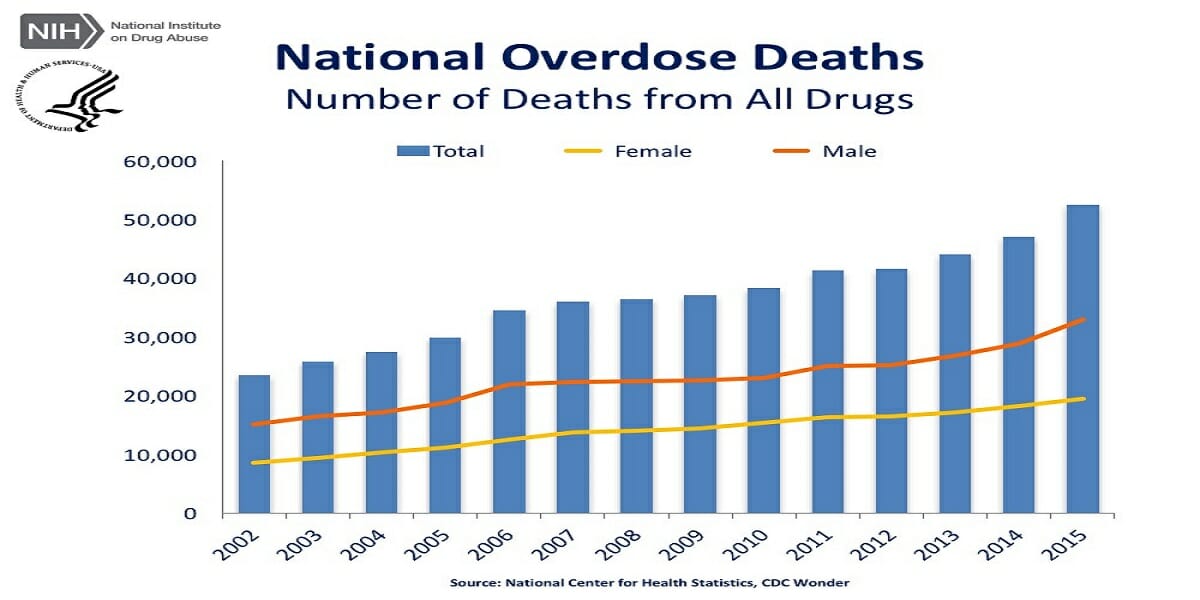More Americans are Finding Themselves in Rehab
A keen survey of stats from the U.S. Center for Disease Control and Prevention reveals that the spike in death rates is majorly attributable to alcohol addictions and drug overdoses. Granted, there is a variety of factors contributing to this spike, but opioids have been singled out as the major cause. Addicts are reportedly abusing prescription opioids, heroin, and synthetic drugs such as carfentanil and fentanyl. These drugs are extremely potent and deadly. Quite unfortunately, that is what drug addicts crave. The dealers are playing along too. Recently, a dealer was nabbed in Massachusetts and after checking his phone, he’d sent a text message to a partner that read: ‘We do not want to kill them, but we only want to bring them to that point.’
Experts agree that Fentanyl is the deadliest in the combination of drugs that are increasing the death toll among Americans. Michael Botticelli, a director of the Grayken Center for Addiction Medicine, says that Fentanyl is much more formidable than morphine or heroin, and users might not realize it is in their system. The drug is unbelievably fast-acting.
A coroner recently testified before Senate and broke the damning news that among African-Americans, deaths have doubled, and it is all due to Fentanyl, a synthetic opioid that users often prefer to combine with cocaine. The coroner, Mr. Thomas Gilson, further noted that dealers deliberately laced cocaine with Fentanyl in a bid to introduce the drug into the African-American population.
The dire effects of opioid and alcohol addictions also manifest in a worrying increase in homicide incidents among young blacks.
Widespread Abuse of Drugs Among all Racial and Ethnic Groups
The trend is not confined to any particular ethnic, class, gender, or geographical group: it is widespread. A Washington Post analysis indicates that the death rate has gone up by four percent, whites by twelve percent, Hispanics by seven percent, and Native Americans by eighteen percent. The increase among Asian Americans is marginal and, therefore, negligible. The overall increase in the death rate is eight percent.
This increase is evident in virtually every state. From the turn of this century, only a paltry ten states experienced a fast-rising death rate for people between the ages 25 and 44 i.e. Kentucky, West Virginia, New Hampshire, North Dakota, Oklahoma, Montana, and Wyoming. These states are predominantly white.
However, from 2010 to 2015, thirty-three states evince a worrying trend of rising death tolls attributed to the drug menace. The death rates have gone up by a few notches, i.e. ten deaths per a hundred thousand people between the ages twenty-five and forty-four, in the thirty-three states, roping in the Midwest Rust Belt and the entire New England. Very few are seeking the drug treatment they desperately need. In Indiana, the death rate rose by thirty-one per a hundred thousand people. But there is some bit of good news, at least in the District of Columbia and Hawaii, where the death rate is taking a precipitous plunge.
The unprecedented increase in death rates across America followed a short reprieve just before 2010 when death rates had been going down for blacks, whites, and Hispanics in cities and metropolitan places. But after 2010, the rates started a steep climb.
Leandris Liburd, a CDC Office of Minority Health director, notes that the stats are disconcerting: we do not want to see increasing death rates for any racial, ethnic, or age group,’ he said. He further notes that multiple factors could account for the rise in mortality, but opioids take the lion’s share of the blame.
A Solution to the Drug Menace
But what is the solution? A crackdown on addicts, users, and dealers? Josh Sharfstein, a director of Bloomberg America Health Initiative, avers that this crisis is taking a toll on communities and the national economy. However, he asserts, a criminal, moral, or judgmental approach will not ameliorate the problem- it will only block effective solutions. What he says is important, especially in the backdrop of pockets of opposition to effective solutions by dissidents who think addicts and drug users should be thrown behind bars.
Therefore, there is an urgent need for stakeholders to devise long-lasting and effective solutions to mitigate the crisis. Ideally, death rates should be taking a nosedive, especially thanks to the technological strides the world has made in the last few decades.













